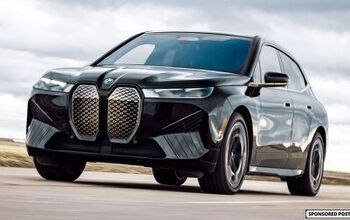2014 BMW 3 Series GT Review

When BMW revealed its intent to give the smaller 3 Series a Gran Turismo derivative like its 5 Series brother, there were cries and protests about the end result. Would it share the divisive styling and heavy dual-trunk system? Would North Americans run in fear from a vehicle completely out of line to their tastes?
Thankfully, that’s not the case.
FAST FACTS
| 1. Riding on a longer wheelbase than the 3 Series wagon, the GT offers 2.3-inches more rear-seat legroom. |
| 2. 18.4 cu-ft of cargo space is more than what’s offered in the wagon. |
| 3. Pricing has yet to be announced but expect to pay a premium over the $41,450 Sport Wagon. |
GENEROUS CABIN ROOM
The GT is 7.9-inches longer and 3.2-inches taller than the new 3 Series Sports Wagon and carryover sedan. More importantly, its wheelbase is around 4.3-inches longer than its more traditional siblings. In fact, the GT shares the same extended platform found under the stretched 3 Series limousine made exclusively for China. The benefits include 2.3 inches of increased rear-seat room than in the Sports Wagon, which makes the GT a more comfortable and versatile package.
BMW claims 7 Series levels of headroom both front and rear, and even for drivers well over six feet tall, the cabin is comfortable no matter which seat you’re in. The rear seatbacks are also adjustable for rake, although since the manual control sits above your outside shoulder, it’s awkward to use when you’re belted in place.
HATCH OPENS EASILY, EVEN WITH YOUR FOOT
Fear not: the fifth door is simple to use with no sign of the contrived dual-opening system on the larger 5 GT. BMW also used a foot-operated trunk system, like Ford does with the C-Max and Escape, which is convenient when your hands are full.
The cargo area is obviously larger than the sedan’s, but more surprisingly, it beats the Sport Wagon’s too. The GT offers 18.4 cu-ft – that’s one more than the wagon – and easily expands to 56.5 cu-ft with the 40/20/40-split rear seats folded. The rear chairs easily tumble forward with one pull of a trunk-mounted handle, which is a simple, mechanical action without the risk of motors or actuators burning out over time.
Like every non-M BMW, the GT doesn’t carry a spare tire. But the area under the cargo floor features a couple separated compartments and room to stow the two-piece removable cargo shelf. Surprisingly, another pneumatic strut supports the raised ‘floor’ to make finding things much simpler.
FIRST BMW TO USE AN AUTOMATICALLY-DEPLOYING SPOILER
Design-wise, the 3 GT is easily recognizable as a 3 Series variant from the front, and at first glance you’d be forgiven for thinking not much was changed in the process. However, the Gran Turismo has its own unique touches, like functional (although questionably styled) fender-mounted vents that allow the larger vehicle to be more aerodynamically efficient. BMW’s first electrically adjustable rear spoiler does the same job, deploying at 70 mph to keep things more stable at speed. Drop back below 45 mph and it’ll retract automatically.
The cabin is instantly recognizable as a BMW with a driver-oriented cockpit, nice materials and expensive trim. The front seats are easily adjustable and supportive, as was the steering wheel with its secondary controls for the audio, cruise control and menu systems.
SPEEDY AND EFFICIENT
The cars we got to play with were 35i variants, meaning the familiar turbocharged 3.0-liter inline-six with 300 horsepower and 300 lb-ft of torque. While a six-speed manual is available in some markets, ours had BMW’s excellent eight-speed automatic transmission sending power to the rear wheels.
An entry-level 2.0-liter turbocharged four-cylinder engine with 241 hp and 255 lb-ft of torque will complement the aforementioned upmarket ‘six’. Other markets will get xDrive all-wheel drive, but nothing’s confirmed for the US yet.
Under full acceleration, the turbo-six sounds great… Otherwise, the plumbing muffles most of the unpleasant noises. The official 0-62 mph (0-100 km/h) run takes 5.4 seconds, while the ‘four’ isn’t far behind at 6.1. The European curb weights given are 3,680 lb for the 328i Gran Turismo and 3,800 for the 335i version, which isn’t terrible given it’s the biggest in the family.
Our 335i GT test car is rated at 22 US mpg in the city and 38 on the highway (EU Cycle), while the 328i version gets 28/44; we’ll have to wait until closer to its late-Summer launch in North America to get more appropriate figures. For comparison sake, both the 328i and 335i are rated at 23/33 mpg by the US EPA so we’d guess the larger, heavier GT to at best match those more realistic numbers.
HANDLING IS TRUE TO THE BRAND
To ensure the 3 GT handles like a BMW, the car uses the same MacPherson struts up front with a five-link setup out back as its siblings and shares the same 50/50 weight distribution. But the GT sits one inch higher than the sedan and Sport Wagon to help with ease of entry.
Sport and M-Sport models put the body 0.4 inches closer to the earth (meaning only a 0.6-inch total gain), but also include stiffer adjustable suspension and larger wheels. The Driver Experience Control will be standard on every model, and uses pre-programmed settings for comfort, sport, sport plus and now Eco Pro. Each one not only adjusts spring damping, but also steering effort, shift timing, throttle response and more.
Eco Pro is the ‘green’ option that when driven sensibly, seriously improves fuel mileage. There’s even an option that gives you Eco Pro routes via the navigation system that’ll help you use nearly 20 percent less gas by avoiding traffic tie-ups too.
Thankfully, the two-day test route avoided the chaos of Palermo, Sicily’s largest city. But the routes around and over the mountainous island proved extremely entertaining, The Gran Turismo is a great driving partner, pretty well hiding its slightly taller driving height.
Our tester was essentially loaded in M Sport trim, which included 19-inch wheels with summer performance tires. Given that the weather on the first day rarely crept into the mid-40s, we were reasonably close to having hockey pucks instead of sticky rubber. The cold temps, along with draining water rushing down most every street, carrying grit and dust onto the mostly smooth roads, meant we kept speeds in check for most of the drive. Add in the occasionally suicidal Italian drivers and keeping on our toes was a real priority.
The GT is nimble enough to not get too fussed over the roads or our driving. It features BMW’s first electrically assisted steering and the final tuning is well judged. Feedback is pretty good through the steering wheel. The car is easy to place, which when the roads twist and turn this much is key to both enjoyment and safety… Also, the big M-Sport brakes never felt too stressed, and only a couple occasions was ABS called into play.
The automatic transmission is well behaved too. On the rare occasion when we got caught behind someone not going balls-out, the unit drops two or three gears in a snap when the gas pedal is suddenly floored. For more control, the optional shift paddles behind the steering wheel came in handy, but with so many gears and such a wide torque curve, they weren’t used often.
THE $64,000 QUESTION
While BMW won’t announce pricing until later this spring, there are a few general assumptions that we can make. Given that the 5 GT is positioned above the sedan when it comes to sticker price, it’d be safe to guess that the 3 GT will hold the same spot against the 3 Series sedan and Sport Wagon. Currently, the 328i sedan has an MSRP of $36,850, while the newly announced 328i xDrive Sport Wagon will be $41,450. Don’t be surprised at starting prices of $45,000 for the 328i Gran Turismo. Also, since the 335i sedan starts at $43,150, the equivalent GT will probably run close to $50,000. And no, there won’t be a 335i Sport Wagon at all, so if you’re looking for the turbo-six with more space than the sedan, the Gran Turismo would be your only option.
BMW will offer the 3 GT in three different ‘lines’ that have unique wheel designs, exterior trim treatments, and interior accents. There will be Luxury, which is the chromier, more traditional option with multi-spoke wheels; Sport, which has gloss-black exterior accents and inside; and Modern, which evokes lighter tones like European furniture. Finally, there’s the optional M-Sport package, which gets a unique front fascia, larger wheels, and the ubiquitous ‘M’ badge thrown around inside and out.
Like the 5 GT, the 3 Gran Turismo appears to have no real natural rivals. The Audi A4 Allroad features a similarly raised ride height and more room than the A4 sedan, but it plays to a different market and can’t match the GT’s rear-seat spaciousness ¬– it’s also only available with a 4-cylinder. Other small luxury crossovers generally are significantly taller or play the faux-off-road card, and in any case, BMW has a couple more ‘traditional’ tall wagons like the X1 and X3 built with those other competitors in mind.
THE VERDICT
Overall, the 3 GT feels like a much more complete product than its 5 GT cousin, and hatch-loving buyers should find plenty to like. Even though its projected price is higher than its cousins, it is the largest, most flexible and stretch-out-able 3 Series yet, which means it’ll entertain you and your passengers too.
LOVE IT
- 7 Series head and legroom
- More cargo capacity than new Sports Wagon
- Drives like a BMW
LEAVE IT
- Fender vents of questionable design
- Most expensive 3 Series
- No optional xDrive yet

Mark has worked as an automotive journalist for over 10 years, starting as a student at Centennial College, in Toronto, by launching an auto-review section in the college paper, The Courier. Since then, he's been Editor of Inside Track Motorsport News and its Streetwise section of new-vehicle reviews and industry news, done stints at Carguide and World of Wheels, and currently works as an award-winning freelancer for AutoGuide.com, MSN Autos Canada and more. He's also a first-time father, so don't be surprised if the frustration of properly installing a car seat creeps into his work.
More by Mark Atkinson































Comments
Join the conversation